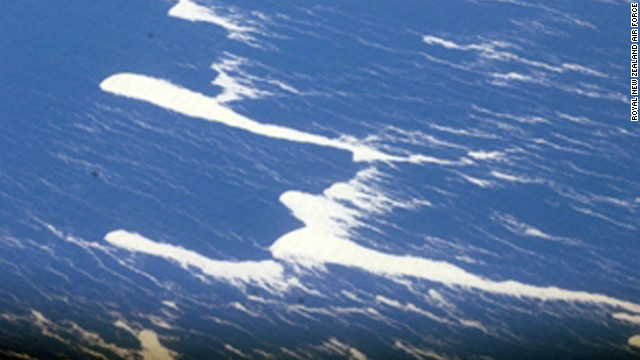'Weirdest thing' floats in South Pacific
August 11, 2012 -- Updated 0236 GMT (1036 HKT)

Officials reported the floating rock shelf to be 250 nautical miles long by 30 nautical miles wide.
STORY HIGHLIGHTS
- Huge swath of pumice brings investigation
- New Zealand Royal Navy vessel gathers samples
- Scientists will try to determine volcanic source
By comparison, the state of Rhode Island comprises approximately 1,200 square miles.
Described by one sailor
who witnessed it as "the weirdest thing I've seen in 18 years at sea,"
the sea of white rock was initially spotted by air and then relayed to a
ship for further investigation, according to a statement released by
the New Zealand Royal Navy.
"The lookout reported a
shadow on the ocean ahead of us, so I ordered the ship's spotlight to be
trained on the area ... as far ahead as I could observe was a raft of
pumice moving up and down with the swell," Lt. Tim Oscar said.
Pumice is typically a
byproduct of lava that has cooled quickly after a volcanic eruption. The
lava forms a rock so lightweight it floats on the water's surface.
"As we moved through the
raft of pumice we used the spotlights to try and find the edge -- but it
extended as far as we could see," Oscar said after the encounter.
Officials reported the
floating rock shelf to be 250 nautical miles long by 30 nautical miles
wide. A nautical mile is about 6,076 feet.
"The rock looked to be
sitting two feet above the surface of the waves, and lit up a brilliant
white color in the spotlight. It looked exactly like the edge of an ice
shelf," Oscar said, according to the statement.
Sailors said taking their
ship directly into the floating pumice to gather samples for research
scientists didn't put the vessel at risk because the rock was so
lightweight.
Volcanologist Helen
Bostock told New Zealand Royal Navy officials the rock came from an
underwater volcanic eruption, and now scientists will work to determine
which volcano was responsible.
According to scientists
who briefed Navy officials, a volcano named Monowai has been active in
the region and the pumice could be a result of recent eruptions.
---------------------------------------------------------------------------

ไม่มีความคิดเห็น:
แสดงความคิดเห็น